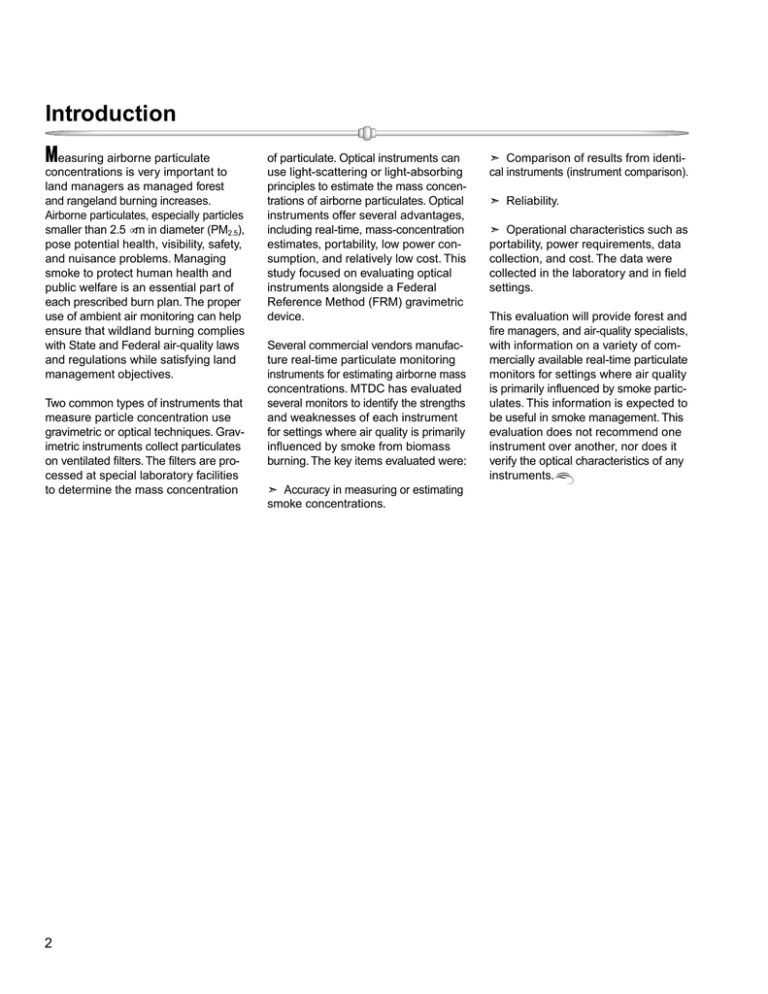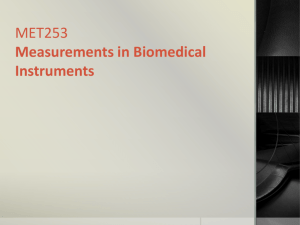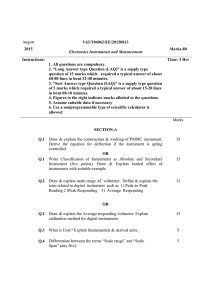Document 11898361
advertisement

Introduction Measuring airborne particulate concentrations is very important to land managers as managed forest and rangeland burning increases. Airborne particulates, especially particles smaller than 2.5 µm in diameter (PM2.5), pose potential health, visibility, safety, and nuisance problems. Managing smoke to protect human health and public welfare is an essential part of each prescribed burn plan. The proper use of ambient air monitoring can help ensure that wildland burning complies with State and Federal air-quality laws and regulations while satisfying land management objectives. Two common types of instruments that measure particle concentration use gravimetric or optical techniques. Gravimetric instruments collect particulates on ventilated filters. The filters are processed at special laboratory facilities to determine the mass concentration 2 of particulate. Optical instruments can use light-scattering or light-absorbing principles to estimate the mass concen­ trations of airborne particulates. Optical instruments offer several advantages, including real-time, mass-concentration estimates, portability, low power consumption, and relatively low cost. This study focused on evaluating optical instruments alongside a Federal Reference Method (FRM) gravimetric device. Several commercial vendors manufacture real-time particulate monitoring instruments for estimating airborne mass concentrations. MTDC has evaluated several monitors to identify the strengths and weaknesses of each instrument for settings where air quality is primarily influenced by smoke from biomass burning. The key items evaluated were: ➣ Accuracy in measuring or estimating smoke concentrations. ➣ Comparison of results from identi­ cal instruments (instrument comparison). ➣ Reliability. ➣ Operational characteristics such as portability, power requirements, data collection, and cost. The data were collected in the laboratory and in field settings. This evaluation will provide forest and fire managers, and air-quality specialists, with information on a variety of com­ mercially available real-time particulate monitors for settings where air quality is primarily influenced by smoke particulates. This information is expected to be useful in smoke management. This evaluation does not recommend one instrument over another, nor does it verify the optical characteristics of any instruments. � Background A comprehensive smoke management plan is essential for the successful use of fire as a wildland management tool. Monitoring ambient air to ensure that smoke does not threaten people or protected areas is an essential element of such a plan. The demands on a particle measurement device in a wildland fire situation are severe. by the Forest Service to help manage a fire and its production of smoke. The data may also be used to anticipate public notification needs as well as to verify the smoke concentration that actually occurs for regulatory purposes. In the future, real-time smoke data may be used with smoke models to produce more accurate predictions of smoke concentrations. Ideally, the instrument should be portable (not require line power), be rugged, (it will be transported in remote areas), be easy to set up and operate by one person, retrieve data in useful forms, and have known accuracy even at low particulate concentrations where smoke would be just a nuisance. Gravimetric or filter-based monitoring techniques have been used for years to quantify mass concentration levels of airborne particulate matter. Filter-based sampling is labor intensive. Filters must be conditioned, weighed before sampling, installed and removed from the instrument, and reconditioned and weighed again at special facilities. Results from the weighing may not be available for days or weeks, depending on the workload at the laboratory. Also, airflow rates and elapsed sampling time The estimated mass concentrations from real-time instruments can be used for a variety of purposes. Real-time smoke concentration data can be used must be carefully monitored and recorded to ensure accurate results. Filter-based techniques integrate samples over a long period of time, usually 24 h (depending on the exposure), to obtain the required minimum mass for analysis. Filter-based techniques can have inaccuracies in both mass and composition due to the loss of volatile and semivol­ atile components. The components can be lost during collection or after collection but before the filter has been analyzed. Optical, real-time, continuous particulate monitoring instruments do not have many of the problems associated with the gravimetric technique. Optical instru­ ments do not require that filters be weighed. They provide concentration estimates that can be released immediately to land managers and the public. Many of these instruments are portable. They can be sited in the areas of greatest interest, usually downwind of burns. � 3 Evaluation Criteria The evaluation criteria for the study are designed to look at the overall use of the optical instrument, its accuracy, comparisons among instru-ments, and cost. In future field applica-tions, the instruments will probably be used by field technicians at various locations throughout the burning season. Portability, ease of set up, ease of data collection, and ease of data manipulation are extremely important. Other consid­ erations a smoke manager should consider when deciding which instrument is most appropriate for each application include: power consumption, calibration requirements, reliability, and similar factors. The list of criteria developed for the evaluation includes: 4 Suitability—The instrument should be able to estimate particulate concentra­ tions generated from smoke at the nuisance level, continuously and in real time. The instrument should be portable, operate on low power, (preferably bat­ teries), be housed in a weatherproof enclosure, and be affordable for a National Forest. Ease of Use—The instrument should be easy to operate and set up. Data collection and manipulation should be straightforward. Calibration should be simple. Reliability—The instrument should be reliable and have strong manufacturer support. Accuracy and Instrument Compar­ ison—Accuracy is based on each instrument’s real-time mass concentra­ tion estimates compared to a gravimetric standard. Estimates from identical instruments were compared to each other. The instruments should be reasonably stable so that accuracy or precision does not vary markedly for a given instrument. � Instruments T wo basic types of instruments were used in the evaluation: optical real-time continuous particulate monitors and gravimetric instruments. Tables 1 and 2 summarize the specifications and accessories for the real-time instruments. Optical Real-Time, Continuous Particulate Monitors The optical real-time, continuous partic­ ulate monitors used in the evaluation may be classified into two types: predominantly light-scattering instruments and predominantly light-absorbing instruments. Light-scattering instruments, called nephelometers, measure the Light-Scattering Instruments amount of light scattered over a known path length and then use a mathematical relationship to estimate the aerosol mass concentration. The particle light scattering (bsp) value is determined by illuminating particles, individually or as a group, and measuring the scattered intensity at different orientations from an incident light source. The orientation of the light source to the particles and receiver will determine whether the instrument is primarily back scattering, forward scattering, or total integrating. The Met One Model GT-640 particu­ late monitor (figure 1) is a complete ambient air sampler using a forward light-scattering detector and built-in data logger. A laser optical sensor detects and measures particulate concentrations up to 10,000 µg/m3. Built-in calibration functions are included. The unit has an internal relative humidity sensor that turns on an inlet heater at 55-percent relative humidity. The monitor can be configured with either a PM10 (particu­ late matter finer than 10 µm) or PM2.5 (particulate matter finer than 2.5 µm) cutoff inlet. Total suspended particulate concentrations can be estimated by removing the cutoff device. Data are digitally recorded and stored with time and date information. Stored data are retrieved through an RS-232 port connected to a laptop computer or Light-absorbing instruments, called aethalometers, quantify the light-absorb­ ing aerosol (black carbon, for example) by depositing the aerosol on a quartzfiber filter and measuring the light transmission or reflectivity. Aethalome­ ters also compute measured light attenuation due to black carbon. Table 1—Specifications of the real-time, continuous, particulate-monitoring instruments evaluated. Met One GT-640 MIE DataRam Radiance Research Optec NGN-3 Andersen aethalometer Price (dollars) Size (inches) Weight (pounds) Mass concentration range (µg/m3) Power requirements Internal calibration 5,382 11,000 4,795 12,900 16,645 15.7 x 11.7 x 8 5.28 x 7.25 x 13.63 22 x 5 x 7 10.7 x 8.2 x 16.5 19 x 12.5 x 10.5 23 11.7 5.7 27 20 0 to 10,000 0 to 400,000 0 to 1,000 0 to 16,666 0 to 1,000 12 V dc, 1 A 6 V dc, 3 A 12 V dc, 1 A 13.8 V dc, 4.5 A Line power, 115 V ac X X 1 2 Requires external supply of span gas. Internal Internal Analytical data storage battery filter X X X X X 1 X X 2 X Data storage with 3.5-in floppy disk installed. Table 2—Accessories for the real-time, continuous particulate-monitoring instruments evaluated. Met One GT-640 MIE DataRam Radiance Research Optec NGN-3 Andersen aethalometer 1 Inlet heater (standard) PM 2.5 cutoff Standard X 4 X Standard X X Environmental enclosure (1 standard) 1 Relative humidity (2standard) 2 Standard Ambient temperature Standard X X X X Self-contained fiberglass enclosure. 2 Internal relative humidity sensor standard, ambient relative humidity sensor optional. 3 Wind sensor, ambient temperature, ambient relative humidity. Meteorological equipment 5 3 X X Standard X 4 5 Continuous heater or proportional, selectable heater. Internal temperature standard, external temperature optional. 5 Instruments The DataRam (figure 2) is a compact, self-contained instrument that internally estimates mass concentration from the measured scattering of light. The instrument can measure particulate concentrations from 0.1 to 400,000 µg/m3 , according to the vendor. The instrument continuously displays the current and time-weighted average mass concentration while logging up to 10,000 data points. Data can be downloaded from the instrument through an RS-232 port. The DataRam can be configured with either a PM2.5 or PM10 impactor head to prevent particles larger than 2.5 or 10 µm, respectively, from entering the optical chamber. For custom calibrations, Figure 1—The Met One Instruments GT-640 particulate monitor with meteorological instrumentation. through an external modem. The logger will record concentrations automatically along with date and time, whenever power is applied. Optional connections on the bottom of the GT-640 allow various meteorological sensors to be attached. All internal components are housed in a weatherproof enclosure. The unit can be powered by an ac or dc power source. 6 Figure 2—The MIE DataRam. or to analyze the chemical composition of particulates, the particulates can be collected on a 37-mm filter located in the instrument’s base. An inline heater may also be installed for monitoring in humid conditions (the manufacturer suggests using the heater when the relative humidity is higher than 70 percent). The instrument’s tubular heater is designed to heat the sampled air stream to evaporate liquid water from airborne particles or to eliminate fog droplets. The DataRam is powered by an internal rechargeable battery or by an external dc or ac power source. The DataRam has a built-in, internal calibration device. Instruments The Radiance Research Portable Nephelometer, Model M903 (figure 3) is a lightweight, low-power instrument designed for portable operation as well as general environmental monitoring. The M903 measures and displays Bscat (backscattering). It does not display a computed estimate of mass concentra­ tion as do the other nephelometers in the evaluation. Mass concentrations can be estimated from the Bscat readings. The instrument has a particulate meas­ urement range of approximately 1 to 1,000 µg/m3 when mass concentration is estimated from Bscat. The instrument has an internal data logger that will store scattering coefficient averages and the operating parameters that are used to estimate the Bscat. The stored data can be retrieved using a personal computer through an RS-232 port. Differ­ ent averaging times and log intervals may be set. The instrument can store approximately 2 weeks of 5-minute averages. A source of a gas, such as Freon, is required for calibration. The unit can be powered by an ac or dc power source. The Optec NGN-3 PM2.5 size-cut neph­ elometer (figure 4) is a self-contained instrument developed to estimate PM2.5 aerosol scattering and mass concen­ trations. The NGN-3 is based on the Optec NGN-2 ambient nephelometer that is used by the IMPROVE program for visibility studies and in other applica­ tions. The NGN-3 integrates the optical design of the NGN-2 ambient nephel­ ometer with both a PM2.5 size-cut separator and an inline sample heater to measure the dry scattering fraction of extinction by fine-mass aerosols. Once measured, the Bscat is converted to mass concentration using a regionspecific, user-selected empirical conversion factor. The NGN-3 continuously outputs both Bscat and a fine-mass concentration estimate with a minimum integration time of 2 minutes. The NGN-3 has no internal data storage capabilities, outputting data in serial or analog form. Portable remote monitor­ ing data loggers such as the Campbell Figure 3—The Radiance Research nephelometer, Model M903, with an attached inlet heater. Figure 4—The Optec NGN-3 PM2.5 size-cut nephelometer. 7 Instruments Scientific CR-23X or a laptop computer are needed for data storage. Gravimetric-Based Instruments The NGN-3 draws ambient air through a sample inlet line. An SKC spiral inlet mounted at the sample air inlet removes coarse particulates from the sample stream. The sample air is heated (to lower the relative humidity) as it enters the nephelometer. The temperature of the heated air is output continuously. To ensure monitoring accuracy, the instrument performs automatic zero calibrations at user-defined intervals. Manual zero and span calibration checks may be performed at any time. An external span gas such as Freon is required for calibration. The NGN-3 can be powered by either an ac or dc power source. Gravimetric-based instruments were used in the evaluation to compare their results to those of the real-time samplers. Gravimetric- or filter-based instruments work by drawing air at a controlled rate through a filter that collects the fine particulate matter. The filter is carefully weighed at a special facility before and after sampling the air. This method provides very accurate results of the quantity of particulate that was collected during the test period. The particulate mass value is divided by the total volume of air drawn through the filter, yielding the average mass concentration for the test period, typically in µg/m3. The gravi­ metric instruments can be configured with impactor or cyclone size-selector devices to remove large particles. Three different gravimetric instruments were used in the evaluation; two Federal Reference Method PM2.5 air samplers and a PM2.5 sampler developed by the Rocky Mountain Research Station’s Fire Sciences Laboratory (Fire Sciences Laboratory) in Missoula, MT. Light-Absorbing Instruments The Andersen RTAA 800 aethalometer (figure 5) collects “elemental” or “black” carbon (BC) on a quartz fiber tape, measuring the optical absorption continuously while the spot of aerosol accumulates. The optical absorption estimations are converted to estimate the mass concentration of BC in µg/m3. A display on the front of the instrument shows the calculated BC concentration. A keypad allows the user to interact with the embedded computer. Data is automatically stored on an internal floppy disk. The instrument also has an RS-232 port and an analog output. The instrument can be configured with a particulate-size cutoff device for selective measurements. The instrument runs on 110 V ac. 8 Figure 5—The Andersen Instruments RTAA 800 aethalometer. Instruments Federal Reference Method (FRM) PM2.5 Air Samplers values and flags indicating anomalies by downloading the summary to a laptop computer. The instruments may be powered by an internal battery, by external batteries, or by solar power. Two different manufacturers of FRM PM2.5 samplers were used in the eval­ uation: the BGI, Inc., PQ200 (figure 6) and the Partisol FRM Model 2000 manu­ factured by Rupprecht and Patachnick (R&P). They both have similar design, performance characteristics, and operational requirements. Both are microprocessor-controlled, volumetric flow rate air-sampling instruments that obtain a valid PM2.5 air sample. The particulates are collected on 47-mm Teflon membrane at a volumetric sample rate of 16.67 L/min after being size discriminated through two inertial separators designed by the U.S. Environmental Protection Agency. Ambient temperature and barometric pressure measurements are made at actual sample conditions. A micropro­ cessor and volumetric flow control sys­ tem are integrated to maintain sampling parameters while sampling data are continuously logged into the processor memory. Memory stores 5-minute actual ambient temperature and pressure conditions along with volumetric sample flow rate, filter temperature, and pres­ sure. The operator recovers measured Filters collected by the BGI PQ 200 were weighed at the Montana Department of Public Health and Human Services Environmental Laboratory in Helena, MT. Filters collected by the R&P Partisol Model 2000 sampler were weighed at IML Air Science in Sheridan, WY. Fire Sciences Laboratory PM2.5 Air Sampler Figure 6—The BGI PQ200 Federal Reference Method PM2.5 sampler. This gravimetric instrument was devel­ oped by the Fire Sciences Laboratory for conducting airborne smoke studies. The instrument uses a computer-controlled volumetric airflow controller to draw air over a 37-mm Teflon filter at a rate of 28.8 L/min. The air is first drawn through a size-selected cyclone device to remove particulate larger than 2.5 µm. The filters were weighed in a special environmentally controlled facility located at the Fire Sciences Laboratory. � 9








